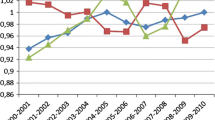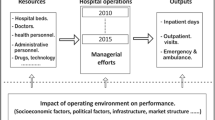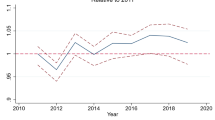Abstract
Activity-based financing (ABF) was implemented in the Norwegian hospital sector from 1 July 1997. A fraction of the block grant from the state to the county councils has been replaced by a matching grant depending upon the number and composition of hospital treatments. As a result of the reform, the majority of county councils have introduced activity-based contracts with their hospitals. This paper studies the effect of activity-based funding on hospital efficiency. We predict that hospital efficiency will increase because the benefit from cost-reducing efforts in terms of number of treated patients is increased under ABF as compared with global budgets. The prediction is tested using a panel data set from the period 1992–2000. Efficiency indicators are estimated by means of data envelopment analysis (DEA) with multiple inputs and outputs. Using a variety of econometric methods, we find that the introduction of ABF has improved efficiency when measured as technical efficiency according to DEA analysis. The result is less uniform with respect to the effect on cost-efficiency.
Similar content being viewed by others
References
S.C. Ahn and S. Low, A reformulation of the Hausman test for regression models with pooled cross-section-time-series data, Journal of Econometrics 71 (1996) 300-319.
M. Arellano and S. Bond, Some tests of specification for panel data: Monte Carlo evidence and an application to employment equations, Review of Economic Studies 58 (1991) 277-297.
B.H. Baltagi, On seemingly unrelated regressions with error components, Econometrica 48 (1980) 1547-1551.
B.H. Baltagi, Econometric Analysis of Panel Data, 2nd Ed. (Wiley, Chichester, 2001).
B.H. Baltagi and Q. Li, A monotonic property for iterative GLS in the two-way random effects model, Journal of Econometrics 53 (1992) 45-51.
R.D. Banker, A. Charnes and W.W. Cooper, Some models for estimating technical and scale inefficiencies in data envelopment analysis, Management Science 30 (1984) 1078-1092.
T.S. Breusch, Maximum likelihood estimation of random effects models, Journal of Econometrics 36 (1987) 383-389.
M. Chalkley and J.M. Malcomson, Contracting for health services when patient demand does not reflect quality, Journal of Health Economics 17 (1998) 1-19.
M. Chalkley and J.M. Malcomson, Government purchasing of health services, in: Handbook of Health Economics, Vol. 1A, eds. A.J. Culyer and J.P. Newhouse (Elsevier Science, Amsterdam, 2000) pp. 847-889.
A. Charnes, W.W. Cooper and E. Rhodes, Measuring the efficiency of decision making units, European Journal of Operational Research 2 (1978) 429-444.
C. Charpentier and L. Samuelsson, Effekter av en sjukvårdsreform - En analys av Stockholmsmodellen (Nerenius och Santerus Förlag AB, Stockholm, 1999).
D. Dranove and M.A. Satterthwaite, The industrial organization of health care markets, in: Handbook of Health Economics, Vol. 1B, eds. A.J. Culyer and J.P. Newhouse (Elsevier Science, Amsterdam, 2000) pp. 1093-1140.
R.P. Ellis, Creaming, skimping and dumping: Provider competition on the intensive and extensive margins, Journal of Health Economics 17 (1998) 537-555.
European Observatory on Health Care Systems, Health Care Systems in Transition - Norway (WHO Regional office for Europe, Copenhagen, 2000).
R. Färe and C.A. Knox Lovell, Measuring the technical efficiency of production, Journal of Economic Theory 19 (1978) 150-162.
M.J. Farrell, The measurement of productive efficiency, Journal of the Royal Statistical Society A 120(3) (1957) 253-281.
U.G. Gerdtham, C. Rehnberg and M. Tambour, The impact of internal markets on health care efficiency: Evidence from health care reforms in Sweden, Applied Economics 31 (1999) 935-945.
J. Hadley, S. Zuckerman and J. Feder, Profits and fiscal pressure in the prospective payment system: Their impacts on hospitals, Inquiry 26 (1989) 354-365.
T.P. Hagen, Agenda-setting power and moral hazard in principal-agent relations: Evidence from hospital budgeting in Norway, European Journal of Political Research 31 (1997) 287-314.
T.P. Hagen and T. Iversen, Målestokk-konkurranse eller kostnadskompensasjon? Analyse av sykehussektoren 1989-1996, Arbeidsnotat 1999:4 (Senter for helseadministrasjon, Universitetet i Oslo, Oslo, 1999).
T.P. Hagen and S.M. Nerland, Sykehuslegenes oppfatning av ISF: Kartlegging basert på en spørreundersøkelse, Working paper 2001:3 (Center for Health Administration, University of Oslo, Oslo, 2001).
I.J. Harris, H. Ozgen and Y. Ozcan, Do mergers enhance performance of hospital efficiency? Journal of Operational Research Society 51 (2000) 801-811.
J.A. Hausman and W.E. Taylor, Panel data and unobservable individual effects, Econometrica 49 (1981) 1377-1398.
D. Hodgkin and T.G. McGuire, Payment levels and hospital response to prospective payment, Journal of Health Economics 13 (1994) 1-29.
E. Kjerstad, Prospective funding of somatic hospitals in Norway - Incentives for higher production? Skriftserie i helseøkonomi, nr 10 (Program for helseøkonomi, Universitetet i Bergen, januar 2000).
V. Koen, Public expenditure reform: The health care sector in the United Kingdom, OECD Economics Department Working Paper ECO/WKP (2000) 29.
J. Kornai, Hardening the budget constraint: The experience of the postsocialist countries, European Economic Review 45 (2001) 1573-1599.
J. Le Grand, Competition, cooperation or control? Tales from the British National Health Service, Health Affairs 18(3) (1999) 27-39.
Ministry of Health and Social Affairs, Ventetidsgarantien - kriterier og finansiering, Stortingsmelding nr 44, 1995-1996 (Statens trykning, Oslo, 1995).
W.K. Newey, Generalized method of moments specification testing, Journal of Econometrics 29 (1985) 229-256.
J.P. Newhouse, Do unprofitable patients face access problems? Health Care Financing Review 11 (1989) 33-42.
J.P. Newhouse, Reimbursing health plans and health providers: Efficiency in production versus selection, Journal of Economic Literature XXXIV (1996) 1236-1263.
C. Propper and N. Söderlund, Competition in the NHS internal market: An overview of its effects on hospital prices and costs, Health Economics 7 (1998) 187-197.
P. Sevestre and A. Trognon, A note on autoregressive error component models, Journal of Econometrics 28 (1985) 231-245.
M. Sommersguter-Reichmann, The impact of the Austrian hospital financing reform of hospital productivity: Empirical evidence on ef-ficiency and technology changes using a non-parametric input-based Malmquist approach, Health Care Management Science 3 (2000) 309-321.
H. Tulkens and P. Vanden Eeckaut,Non-parametric efficiency, progress and regress measures for panel data: Methodological aspects, CORE Discussion Paper no 9316, Louvain-la-Neuve: Center for Operations Research and Econometrics, Universite Catholique de Louvain (1993).
P. van den Noord, T.P. Hagen and T. Iversen, The Norwegian health care system, Economics Department working paper no. 198 (OECD, Paris, 1998).
H. White, Asymptotic Theory for Econometricians (Academic Press, Orlando, 1984).
C. Yip and K. Eggleston, Provider payment reform in China: The case of hospital reimbursement in Hainan Province, Health Economics 10 (2001) 325-339.
Author information
Authors and Affiliations
Rights and permissions
About this article
Cite this article
Biørn, E., Hagen, T.P., Iversen, T. et al. The Effect of Activity-Based Financing on Hospital Efficiency: A Panel Data Analysis of DEA Efficiency Scores 1992–2000. Health Care Management Science 6, 271–283 (2003). https://doi.org/10.1023/A:1026212820367
Issue Date:
DOI: https://doi.org/10.1023/A:1026212820367




